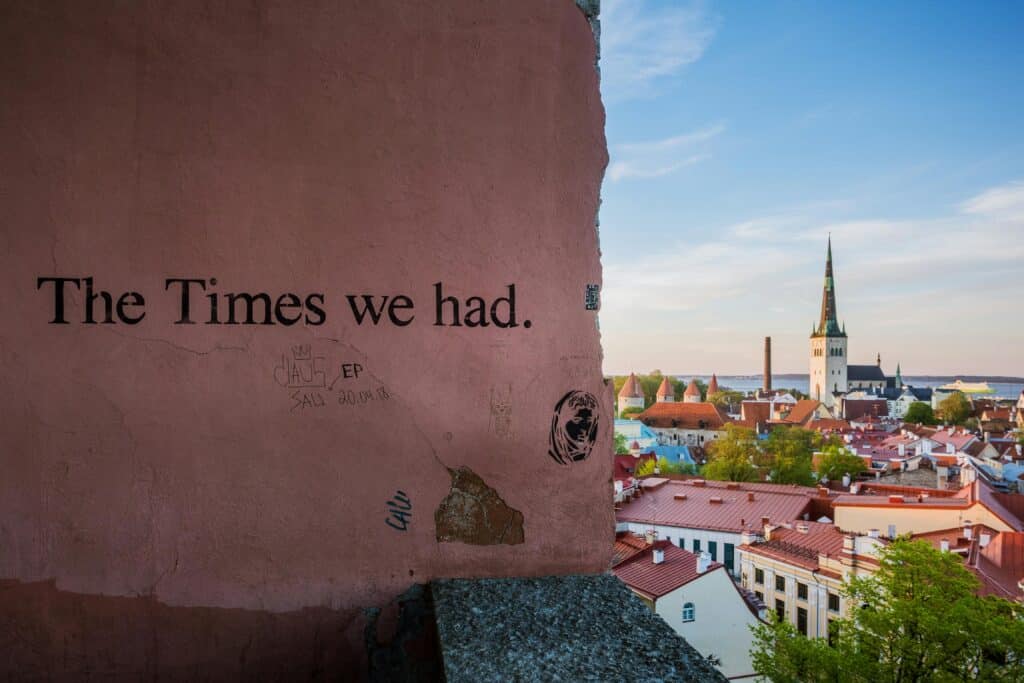
Estonia’s capital Tallinn is a charming city located in the Gulf of Finland, just 90 km across the water from Helsinki.
It’s a town where medieval history meets cutting-edge innovation—and it’s precisely this unique blend of old-world charm and modern amenities that make it an increasingly attractive destination for expats, digital nomads, and families.
Whether you’re drawn by its rich history, vibrant start-up culture, or the allure of a quieter European life, Tallinn has something for everyone. This Remitly guide is designed to help you settle in effectively, ensuring a smooth transition to your new life in Estonia.
Table of Contents
An overview of Tallinn
Tallinn was founded in 1248, making it one of the oldest capital cities in Northern Europe. It has evolved from a key trading hub in the medieval period, to the vibrant capital with a booming tech industry that we see today.
Its history is reflected in the architecture, too. The city’s Old Town is a UNESCO World Heritage Site, home to cobblestone streets and gothic spires, heavily influenced by German styles. They blend seamlessly into the sleek glass facades of its new, modern business districts.
The city is renowned for its thriving start-up scene, often dubbed the “Silicon Valley of Europe.” Industries such as IT, Fintech, and E-commerce play significant roles in the local economy, attracting talent and a sense of entrepreneurship from all over the world.
Essential facts about Tallinn
|
Population |
425,000 |
|
Popular Neighborhoods |
Kesklinn, Kalamaja, Lasnamäe, Mustamäe |
|
Average Rent for a 1-bedroom Apartment |
€300-€1000 |
| Top Industries
|
IT, , Startups, Financial Services |
|
Number of Expats |
50,000-60,000 |
Neighborhoods and finding housing in Tallinn
If you’re looking to settle in Estonia, finding the right place to live is a crucial first step. The two most popular real-estate platforms in Tallinn are City24.ee and KV.ee.
If you’re considering buying a property, though, you could get in touch with local real-estate agencies. The housing market in Tallinn has been growing steadily, with property values rising.
Choosing the right part of town
Like any city, Tallinn’s different neighborhoods cater to a range of budgets and lifestyles. Here are our top recommendations, depending on what you’re looking for:
- Kesklinn (the city center): The place to be if you want to be in the heart of the action. This is the Old Town, the city’s cultural heartbeat, while it also houses all modern amenities. The downside? Rent is higher than in other parts of town, with one-bedroom apartments ranging from €600 to €1,000 per month.
- Kalamaja: A popular choice among young professionals and families and a quieter, more residential area. It offers a blend of charming wooden houses and modern homes, and rents average around €500 to €800 per month for a one-bedroom apartment.
- Lasnamäe: Lasnamäe is a built-up district of Soviet-era apartment blocks and is home to a large Russian-speaking community. While it may lack the old-style charm of other neighborhoods, there is great access to public transport and plenty of shopping centers—plus, rent ranges from €300-€500 per month.
- Mustamäe: Another more budget-friendly option, which enjoys more green spaces than nearby Lasnamäe. The area is popular with students due to its proximity to Tallinn University of Technology, giving it a younger vibe. A one-bedroom apartment ranges from about €350 to €600 per month.
Public transport in Tallinn
Tallinn has a fantastic public transport system that makes it easy to get around. Like much of Europe, the extensive network of buses and trams covers pretty much every corner of the city—what’s not so common, though, is that in Tallinn, it’s completely free for registered residents.
Top tip: If you’re planning to commute to work, get your hands on a Smartcard to enjoy free and unlimited travel across the whole network.
Tallinn is becoming increasingly bike-friendly, too. Cycle lanes are being installed across the city and bike-sharing apps like Citybike and Rekola offer an affordable and healthy way to get from A to B.
Driving in Estonia
If you plan to drive, you can use your foreign license for up to 12 months after you become a permanent resident. After that, you’ll need to exchange your foreign driving license for an Estonian one. It’s a straightforward process for most European Union, American and other international licenses. Simply head to the Estonian Road Administration in person with your current license, passport, and residence permit to make the switch. They also have an online service.
Essential services and amenities
Once you’ve found somewhere to live and have started to get your bearings in your new city, the next step will be understanding the basic services. Here’s our rundown.
Healthcare in Tallinn
Estonia has a top-notch public healthcare system and if you’re employed in the country, you’ll have access to it through social security payments. All you have to do is ensure you’re registered with the Estonian State Health Insurance Fund (Tervisekassa).
If you’d rather opt for private healthcare, Tallinn has a range of clinics and hospitals. The big plus for expats is that many of these facilities have English-speaking staff.
Utilities
Setting up your utilities in Tallinn is relatively simple. Electricity and water can be registered online or through your landlord.
Popular providers include Elektrilevi for electricity and Tallinna Vesi for water, both of which have English websites.
With internet access being pretty much as vital as water these days, we’ve got good news for you—Estonia boasts some of the fastest broadband speeds in the world, with companies like the Swedish Telia or the Finnish Elisa offering a variety of packages.
Other services
In order to gain access to general local government services, you’ll have to register your place of residence. This is an essential step for obtaining your ID card.
You can complete this procedure at the Police and Border Guard Board (PPA). You’ll need an ID card for accessing everything from healthcare to banking and public transport.

Opening a bank account
Major banks in Estonia include Swedbank, SEB, and LHV, all of which offer services in English. Opening an account is straightforward—all you’ll typically need are a passport, residence permit, and proof of address.
What’s more, in most cases, you’ll be able to open an account online in just a matter of minutes! And if you need to transfer any money into your new account, we’ve got you covered!
Cost of living in Tallinn
The cost of living in Tallinn, as in any city, will vary depending on your lifestyle. Groceries, public transport, and utilities are generally affordable, but dining out and entertainment can add up.
On average, a single person’s monthly expenses, excluding rent, range from €600 to €900.
Tax regulations
Familiarize yourself with local financial regulations, especially when it comes to taxes. Estonia has a flat income tax rate of 20%, and if you’re working in the country, your employer will typically handle the tax deductions.
However, if you’re self-employed or running a start-up, you’ll need to handle your tax obligations through the e-Tax Board. Understanding the tax system will help to avoid any penalties, especially if you’re planning to apply for permanent residence or citizenship.
Social life and community in Tallinn
Besides all of the practical advice on offer in this guide, the single most valuable tip we can offer to help you settle in Tallinn is this: Do all you can to integrate into the local community. There are all kinds of ways to do it. Besides learning the Estonian language, joining social clubs, attending meetups, or participating in local events are great ways to start.
Here are some platforms to help:
- International House of Estonia hosts regular events for expats.
- Meetup.com is an international platform set up for people with similar interests to socialize together.
- Internations is a popular community-based website for finding like-minded individuals.
Tallinn has a buzzing social scene. It boasts a vibrant nightlife, especially in areas like Telliskivi Creative City, where you’ll find great bars, restaurants, and live music venues.
Estonia’s capital is also home to numerous museums, parks, and sports clubs. Kumu Art Museum and Lennusadam Seaplane Harbour are must-visits for history and art lovers.
For those who prefer the great outdoors, the impressive Kadriorg Park dates back to 1718, when Peter the Great ordered the construction of a European-style summer palace. Nowadays, it offers beautiful walking trails and an idyllic escape from the bustle of the city.
Alternatively, the Pirita district is perfect for a relaxed day at the beach or a picturesque bike ride along the coast.
Finding a job in Tallinn
Tallinn’s digital-forward approach makes it a fantastic place to do business. What’s more, its location makes it a strategic gateway to the Baltics, Ukraine, Russia, and Northern Europe, with Helsinki, Latvia’s capital Riga, and St. Petersburg just a short trip away.
The Estonian government has made a real effort to dynamize its economy in recent years by looking to attract tech companies, from start-ups to big industry players. Having successfully cultivated a hive of entrepreneurship, the job market in Tallinn is now thriving.
The city is home to many major employers, such as Bolt, Microsoft and Lingvist, all of which contribute to the city’s reputation as a tech hub. If you’re looking for work, skills in IT, engineering, or fintech will be a real advantage.
In 2023, the average monthly salary in Estonia was €1,832.
Studying in Estonia
For those interested in studying abroad, Tallinn is home to several universities and colleges, including Tallinn University of Technology (TalTech) and Tallinn University. If you are a non-EU/EEA citizen, you will need a visa and/or residence permit depending on the length of your stay. Visit the Study in Estonia webpage for further information.
Estonian higher education is well respected on a global level. The country is part of the Bologna Process, an attempt to standardize higher education across Europe, and its university diplomas are internationally accepted.

Visas and permits for living in Tallinn
Understanding the immigration regulations is a crucial part of coming to work or study in Tallinn. EU citizens and their family members don’t require a visa to live and work in Estonia, but they must register their place of residence within three months of arrival.
Non-EU citizens will need to apply for a temporary residence permit, which can be done through the Police and Border Guard Board. Start this process early, as it can take several months to complete.
Estonia is one of the most digitally advanced countries in the world. Its e-Residency allows non-Estonians to start and manage an EU-based company online and is a perfect example of the country’s take on modern business practices.
Practical tips for newcomers to Tallinn
As with any new city, there are practicalities to consider when settling. Safety is generally not a major concern, as Tallinn is one of the safest capitals in Europe. However, it’s still wise to stay vigilant, especially in crowded tourist areas where pickpocketing can occur.
Be aware of common scams, such as overpriced taxi rides from the airport. Ride-hailing apps like Bolt are available.
Understanding local customs and etiquette can also help you feel more at home. For instance, Estonians are generally reserved but friendly, and a handshake is the most common greeting.
When visiting someone’s home, it’s polite to bring a small gift, such as flowers, chocolates or even the favorite national dish, verivorst. Oh, and punctuality is highly valued, so bear that in mind for your appointments and social gatherings.
Useful resources to help you settle in
Having sound guidance and information on hand will make your adjustment to life in Tallinn far easier. Here’s a quick list of resources for newcomers to the city:
International House of Estonia: It offers assistance with paperwork, job searches, and general social integration.
Work in Estonia: This website is another fantastic source of information on everything from finding a job to navigating the nation’s healthcare system.
Eesti.ee: The official government portal for citizens and residents. Here you can access services related to health insurance, taxes, residence permits, and more.
Tallinn.ee: The official website of Tallinn City Government, offering information on local services, events, public transportation, and essential services for residents.
FAQ
Yes, Tallinn is a great place to live! It offers a blend of historic charm and modern amenities, a high quality of life, excellent public services, and a vibrant start-up scene. The city is safe, and its compact size makes it easy to navigate.
Yes, a US citizen can move to Estonia. You’ll need to apply for a temporary residence permit if you plan to stay long-term. The new Aliens Act also includes provisions for entrepreneurs and start-up founders, which makes Estonia an attractive destination for those looking to start a business. US citizens can apply for a residence permit specifically for entrepreneurship if they meet the criteria.
To live comfortably in Tallinn, a single person typically needs around €1,200 to €1,500 per month, including rent, utilities, groceries, and leisure activities. The cost can vary depending on your lifestyle and accommodation choices.
Benefits include a high standard of living, excellent digital services, and a welcoming environment for start-ups. Drawbacks might include the cold winters and the relatively reserved local culture, which can take time to adapt to.
A temporary residence permit allows you to live in Estonia for up to five years. After this period, you can apply for a long-term residence permit or permanent residence if you meet certain criteria, such as continuous residence and sufficient income.
Some other cities in Estonia are Tartu, Narva, Pärnu, Kohtla-Järve and Viljandi. Tartu is the second-largest city after Tallinn and has a population of around 95,000.
